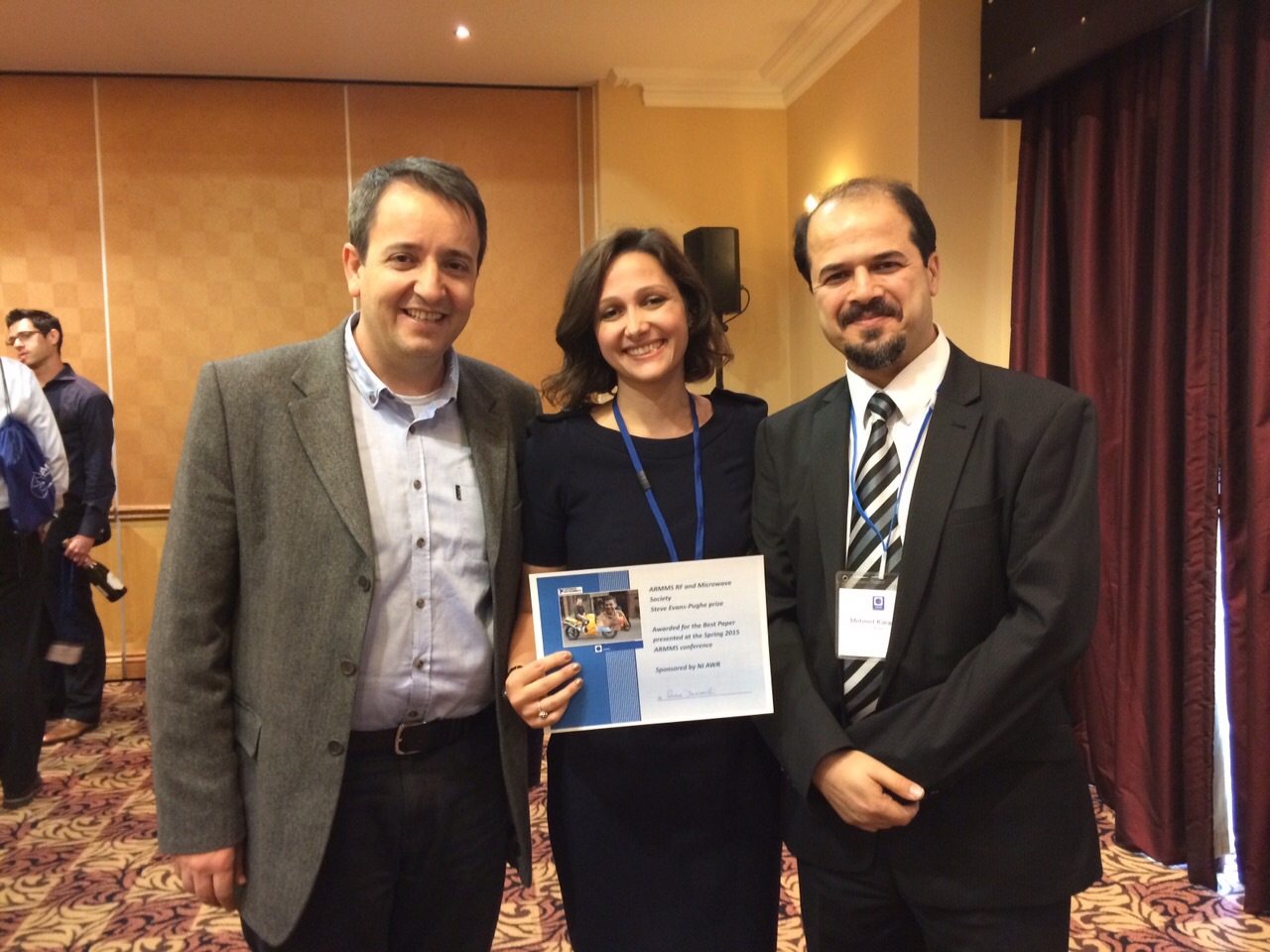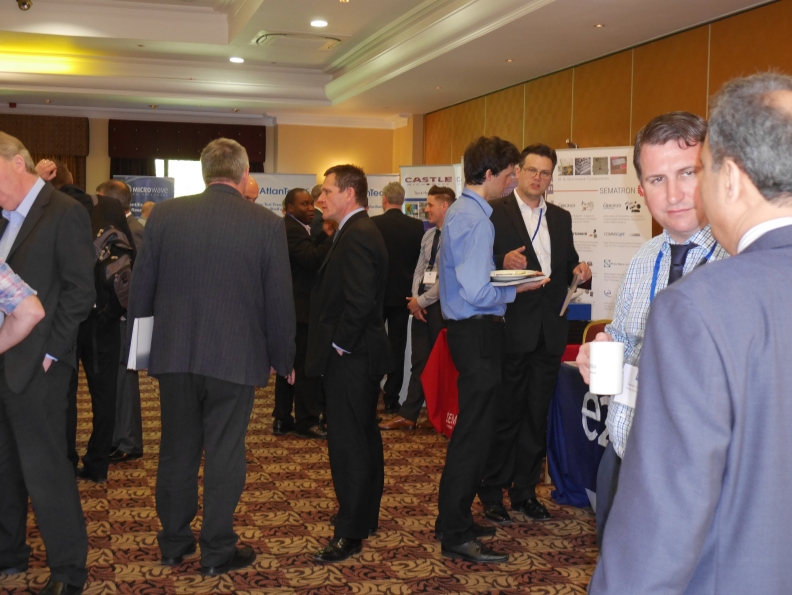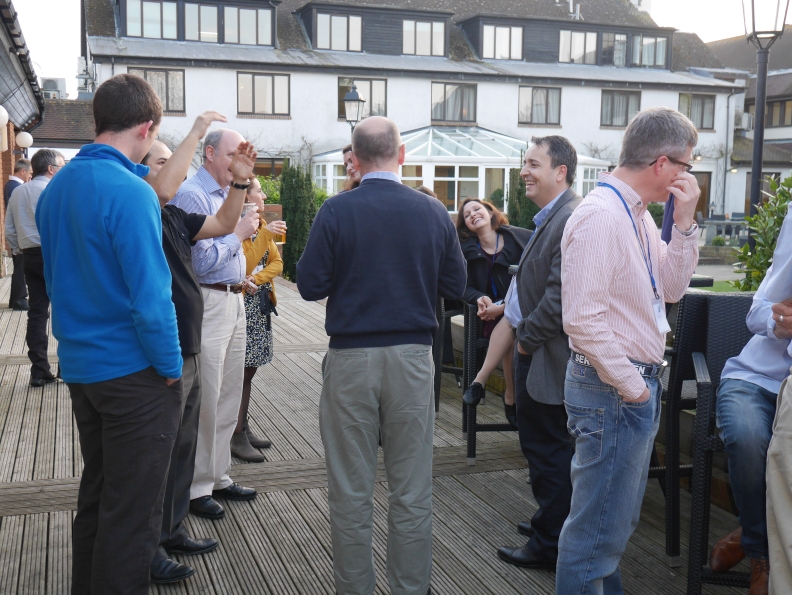Meetings commence at 12:30pm on the Monday, starting with lunch.
Young Engineer Sponsorship: The ARMMS RF & Microwave Society provides sponsorship for young engineers (28 or below) who have had papers accepted for presentation at each meeting. Sponsorship is £200 cash plus free attendance (including conference dinner and overnight accommodation). Potential candidates should identify themselves as eligible at time of submission and state their date of birth. This offer is limited to a maximum of 2 places per meeting. The sponsored places at the April 2024 meeting were awarded to Richard Cavanagh of PRFI and Edward Pipe of Slipstream.
Best Paper Award: The Steve Evans-Pughe prize is awarded to the best presenter at each meeting. The prize is sponsored by Cadence. The best paper prize at the April 2024 conference was awarded to William McGenn of The University of Manchester with Jean-Baptiste Urvoy of The University of Cardiff taking the second place.
If you are interested in submitting a paper for presentation at this conference, please contact the technical coordinator (details below). Papers currently listed below are those already accepted. The deadline for submissions is 23rd of February 2024. For exhibition enquiries please email exhibition@armms.org, for all other enquiries please email enquiries@armms.org
 |  |  |
Double Tree by Hilton Oxford Belfry
The Oxford Belfry
Nr Thame
OX9 2JW
| Web | https://www.theoxfordbelfry.co.uk |
Tudor Williams
Filtronic
| Tel | +44 (0) 1740 618800 |
| tudor.williams@filtronic.com |
3-D Over-the-Air Test Setup for the Evaluation of mmWave Reconfigurable Intelligent Surfaces | |
| Fabian Bette | |
| Rohde & Schwarz | |
Given the increasing attention of Reconfigurable Intelligent Surfaces (RISs) for modern millimeter-wave (mmWave) systems and future 6G applications, the assessment and evaluation of RISs becomes essential. After analyzing the state-of-the-art in the context of RIS test & measurement aspects, a novel 3-D capable Over-the-Air (OTA) test setup is presented. With the help of this setup, the reflection characteristics of a mmWave RIS can be assessed for various angles of incidence and feed antenna distances. Following a detailed setup description, exemplary reflection pattern measurement results of a pin-diode based RIS prototype, working at a frequency of 28 GHz, are presented. Subsequently, possible setup extensions are discussed and the suitability of the proposed setup for measurements with modulated signals (e.g. 5G New Radio (5G NR)) and end-to-end performance measurements, is pointed out. The results show that the proposed test approach is appropriate for the OTA characterization of RIS modules in the mmWave frequency range. | |
A Novel Architecture for a 100MHz - 44 GHz Downconverter with 1 GHz IF Bandwidth and Gapless Coverage | |
| John Lillington | |
| Libra Design Associates Limited | |
This design has evolved to overcome the shortfalls in earlier designs, namely, a top frequency of only 18GHz, gaps in the coverage due to inadequate RF filter overlap and an instantaneous IF bandwidth of only 800MHz. This novel design takes advantage of an increasing range of wide bandwidth IQ converter, switched and tuneable RF filter banks and Synthesiser chips, extending well into the mm-wave bands. This paper aims to look at the trade-offs between the various competing architectures together with some performance parameters for the chosen solution. | |
Additively Manufactured Passive Devices and Antennas from 50 to 500 GHz | |
| Lu Qian, Talal Skaik, Yi Wang | |
| University of Birmingham | |
3D printing (or additive manufacturing) has become an increasingly common manufacturing tool for microwave passive devices. The technology has made the jump from laboratories to real world applications and been used in space missions. This relatively new manufacture technique has also started finding applications at even higher frequencies into millimeter-wave (mm-Wave) and sub-terahertz (sub-THz) regime, as ‘high-precision’ 3D printers have become available. This talk will use a few device examples, such as waveguides, cavity filters and antennas, to demonstrate the capability as well as the limitations of both polymer and metal 3D printers that have a manufacture tolerance of under 10 mm. The talk will also touch on the development of the end-to-end process, such as surface polishing and plating, around 3D printing for such devices. | |
An IF to IQ Conversion and Power Supply Interface for Integrating a Terrestrial E-Band Transceiver on a Satellite Payload | |
| Michael Guess | |
| Filtronic | |
A customer requirement to rapidly demonstrate a narrowband E-band link, between a ground station and satellite payload is described. The mission priority is speed of deployment and compatibility with an existing modem that provides intermediate frequency (IF) baseband in/outputs. A mmW module designed for terrestrial applications is reviewed, with consideration of the power supply requirements and an assessment of component and material suitability made, for Low Earth Orbit (LEO) applications. A discussion of the direct-conversion vector modulator used on the module is presented, with emphasis on the technical means by which suppression of unwanted sidebands (SBS) and local oscillator cancellation (LOC) is achieved. The topology of an interface board is described, with the requirements for - and control of - power supplies defined. The technical means by which an IF signal is converted for use with the direct-conversion vector modulator is then presented, along with a discussion of the advantages and disadvantages of such an approach, with respect to the SBS and LOC. A summary of the performance of the final assembly is presented, in the context of the customer’s commercial requirements. | |
Design of High Power High Efficiency GaN Amplifiers | |
| Jack Brunning | |
| Gallium Semiconductor | |
In this presentation an introduction to GaN device technology is provided before explaining the design flow Gallium Semiconductor developed and successfully implemented to enable the accurate modelling, design and fabrication of high power, high efficiency RF GaN devices. The relevance of not only accurately modelling the core model, but also the interconnecting bondwire arrays, is shown such that the final packaged device produces desirable RF performance characteristics suitable for use in high performing and reliable RFPA applications. The complete packaged device is modelled using a single design environment (DE) and includes an accurate and computationally efficient package FEM model. An overview of the fabricated measurements including S-Parameter, fundamental and harmonic load pull across a number of devices are shown. | |
Dielectric measurements at mmWave | |
| Xiaobang Shang | |
| NPL | |
Accurate measurement of material properties (i.e., permittivity and loss tangent) at millimetre-wave frequencies is essential for the development of circuits and systems for communications and automotive radar sensor applications. In this paper, we will briefly review the mainstream measurement techniques and focus on a guided free-space technique using commercially available Material Characterisation Kits (MCKs). Recent work conducted by NPL around MCKs will be summarised, including improved TRL calibration method, data filtering techniques, and phase compensation scheme for improved permittivity accuracy. Comparisons with open-resonators and time domain spectroscopy (TDS) methods using common kinds of dielectric materials will also be presented. | |
E and W-Band GaN MMIC Power Amplifiers | |
| Johnathan Leckey | |
| MMIC-Labs | |
Use of the mm-wave bands with inherent multi-GHz wide channel bandwidths, are crucial to enable the high-capacity, high-speed data transmission capabilities of next generation mobile and satellite communications networks. Recent improvements in available GaN foundry processes to achieve 0.1um gate geometries means that realising multi-Watt MMIC power amplifier solutions at E-band (60-90GHz) and W-band (90-110GHz) is becoming feasible. After review and selection of a candidate process, design of a 2W E-band MMIC power amplifier at 71-76GHz was carried out. Small and large signal device characterization results on the candidate 0.12um GaN/SiC process, and development of a quasi-distributed large signal model for use in the design will be described along with and the finalized MMIC layout and simulated performance results. | |
Engineering a Single Sweep, Broadband On-wafer VNA Prober, 900 Hz ? 220 GHz | |
| Rob Sloan | |
| Microwave Inspection Technologies Ltd | |
Recent spectrum allocations above 100 GHz have been made to support the necessary bandwidths exceeding 10 GHz. These bandwidths are envisioned for 6G applications typically ultra-low latency comms or x-haul are cited as applications amongst others. Currently W-band (92 – 114 GHz), D-band (130 – 175 GHz) and above are of prime interest to telecoms companies. In turn this creates a scramble to develop systems and chips capable of operating at these frequencies. Further US CHIPS Act and the EU equivalent will be a boost for large-scale chip manufacturers and fabless companies. Therefore there is a need for single sweep probers capable of measuring S-parameters from low frequencies out to at least 220 GHz. Here I describe how one solution was developed to enable two network analyser heads to be sequentially swept and diplexed into a single port at the probe tip. This partnership involved FormFactor, Keysight, Dominion MicroProbes Inc. and VDI and developed a probe working with Keysight extender heads together with VDIs frequency extenders. Here I describe the design steps taken to produce the diplexed probe and show some results of devices measured at its introduction at the European Microwave Conference in London in 2021. | |
Evaluation and Improvement of mm-wave Load Pull Measurement accuracy | |
| Alexander Baddeley, Paul Tasker, Roberto Quaglia | |
| Cardiff University | |
Load pull measurements at mm-wave are a challenging task which is worth undertaking to obtain important information on the devices that can enable advanced design, accurate modelling and important insight into technology. This contribution will discuss the undergoing analysis of the main causes of uncertainty in mm-wave load pull systems and some idea that have been tested and validated on the latest device technologies to improve the confidence in the experimental results obtained. | |
Extending the Use Case for GaN Devices to Low Power Applications | |
| C. Clifton (1), C. Mimis1, A. Lawrenson (1), Satoshi Taniguchi (2), Katsuhiko Takeuchi (2), Kunihiko Tasai (2), Katsunori Yanashima (2) | |
| 1: SSS-E Technology Exploration, 2: SSS Analog LSI Business Division Analog Device Development Department | |
So far, the focus of GaN (Gallium Nitride) processes have been towards the infrastructure and military applications that require high power and performance. However, the ever increasing demands of higher data throughputs and features mean that it is battery and power constrained terminals and equipment that will most benefit from the increased efficiency and power density of these high performance processes. The challenges of low voltage operation need to first be overcome, in addition to other technical and commercial barriers. This presentation will highlight the high performance low voltage operation of a GaN on Silicon device and how, with appropriate circuit topologies, it can readily address the future challenges of low power consumer and infrastructure applications. | |
Generation of Complex Waveforms through the Development of a Wideband Digitally Controlled Power Amplifier | |
| Edward Pipe | |
| Slipstream | |
With increasing data rates driving bandwidth and high PAR signals demanding higher backoff efficiencies, the typical microwave transmitter is fundamentally limited by a bandwidth/ efficiency trade-off made in the output stage RFPA. Recent LMBA developments have suggested there is a route to bypass the fundamental bandwidth limitations of typical high-backoff topologies, whilst still being able to achieve enhanced backoff efficiency. More generally, this promise extends to remove the limitations of typical RF transmitters, and drive towards frequency and output power agnostic hardware, where digital control of the RF signal can be utilised to optimise the output impedance of the RFPA in real-time. This presentation will discuss some of the investigations and experiments undertaken to gain a better understanding of the challenges and limitations of the LMBA approach, and to explore the potential for digitally controlled RFPAs for Software Defined Radios of the future. | |
Highly Integrated, Cryogenic LNA Based Receivers for Millimetre and Sub-millimetre Wavelength Radio Astronomy | |
| William McGenn (1), Hui Wang (2), Elle Franks (1), Brian Ellison (1), Gary A. Fuller (1), Danielle George (1), Peter G. Huggard (2) | |
| University of Manchester (1) and STFC Rutherford Appleton Laboratory (2) | |
The development of sub-100nm gate length Indium Phosphide (InP) Pseudomorphic High Electron Mobility Transistor (pHEMT) technology has pushed the capabilities of Low Noise Amplifiers (LNAs) enabling operation in the millimeter and sub-millimeter frequency ranges. This is in turn enabling LNA based receivers to be used for radio astronomy observatories, however there are still challenges that need to be addressed in order to maximise the potential of this receiver technology. We have recently completed fabrication of the sixteen-pixel, W-band (70-116GHz) CARUSO receiver, and we will present here the lessons that have been learnt from this project as well as how we are further miniaturizing these components as we work towards future integrated millimetre and sub-millimetre wave receiver technologies. | |
NPR - What is it, How Can I Simulate it and How do I Measure it? | |
| Richard Cavanagh, Rob Smith and Dave Collins | |
| PRFI Limited | |
Noise Power Ratio (NPR) is a figure of merit for the linearity performance of RF and microwave amplifiers. It can be a useful metric for multi-carrier systems and provides an indication of the in-band distortion caused by multiple carriers on other channels. NPR has been used for many years and can be measured using noise generators, filters and a spectrum analyser. More recently the availability of vector signal generators has allowed a higher degree of flexibility for NPR measurement set-ups. There are many approaches to predicting NPR but simulation at the circuit level requires the availability of accurate large-signal transistor models. Two techniques can then be considered, one using a simulated broadband noise source as the input and the other using many individual carriers. This presentation will provide an overview of NPR and describes how it can be simulated using Keysight’s ADS. Options for measuring NPR will then be described and practical NPR measurements of several PRFI designed mmWave MMIC amplifiers will be presented. The measurement set-up makes use of a Rhode & Schwarz vector signal generator to produce the input signal and a spectrum analyser to measure the output and determine the NPR. | |
RFPA Design for Industrial, Scientific and Medical Applications | |
| Steve Cripps | |
| Cardiff University | |
The ISM sector has been a growth area in recent years for applications of microwave engineering. These applications include various forms of heating, and more controversial uses which exploit so-called “non-thermal” effects of microwave exposure on biological and chemical samples. This talk will not attempt to address the questions surrounding the provenance of such effects but will discuss the challenges presented to the PA designer in delivering substantial amounts of microwave power to targets that vary in size and microwave impedance properties and are far from 50 Ohm loads. ISM applications may represent a large new market for RFPA products which may utilize alternative technologies and design approaches than those that have evolved for the conventional microwave applications such as telecom and radar. | |
The Orthogonal LMBA as an Efficiency Enhancement Technique | |
| Jean-Baptiste Urvoy (1), Steve Cripps (1), Nick Rawlins (2), Roberto Quaglia (1) | |
| Cardiff University (1) and Leonardo UK (2) | |
The Orthogonal Load Modulated Balanced Amplifier (OLMBA) provides an effective and efficient way of applying LMBA load modulation, which has proven useful for extending the amplifier bandwidth and mitigating the performance loss in case of load mismatch. This paper explores another dimension enabled by load modulation: back-off efficiency enhancement. Firstly, a systematic approach to experimentally test an existing OLMBA in this context is presented, focussing on the simplification of the control parameters domain. Secondly, it is shown that, by applying the Cardiff behavioural modelling framework, the design and system level simulation of the OLMBA can be accelerated. | |
Companies booking two or more delegate places are able to take part in the commercial exhibition that accompanies the conference. Please note: there is a maximum of 20 exhibition tables at each meeting, these are offered on a first come basis. Booking two delegate places does not guarantee an exhibition space, please email exhibition@armms.org to check availability and reserve and exhibition space.
The society would like to thank Saras Technology for sponsoring the April 2024 meeting.
Contributions are invited with an emphasis on RF and microwave design, research, testing and associated subjects. An oral presentation will be made at the meeting and a written paper will be required for publication in the society digest, which is distributed to delegates at the meeting. Prospective speakers are requested to submit a title and a short abstract to the technical coordinator (see above) as soon as possible.
Click here to view our Guidelines for Authors
Click here to view our Publication Release Form